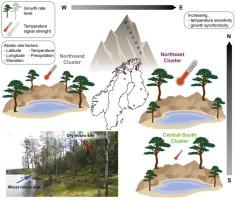当前位置:
X-MOL 学术
›
Dendrochronologia
›
论文详情
Our official English website, www.x-mol.net, welcomes your feedback! (Note: you will need to create a separate account there.)
Micro-site conditions affect Fennoscandian forest growth
Dendrochronologia ( IF 3 ) Pub Date : 2021-02-01 , DOI: 10.1016/j.dendro.2020.125787 Claudia Hartl , Elisabeth Düthorn , Ernesto Tejedor , Andreas J. Kirchhefer , Mauri Timonen , Steffen Holzkämper , Ulf Büntgen , Jan Esper
Dendrochronologia ( IF 3 ) Pub Date : 2021-02-01 , DOI: 10.1016/j.dendro.2020.125787 Claudia Hartl , Elisabeth Düthorn , Ernesto Tejedor , Andreas J. Kirchhefer , Mauri Timonen , Steffen Holzkämper , Ulf Büntgen , Jan Esper

|
Abstract The long tradition of dendroclimatological studies in Fennoscandia is fostered by the exceptional longevity and temperature sensitivity of tree growth, as well as the existence of well-preserved subfossil wood in shallow lakes and extent peat bogs. Although some of the world’s longest ring width and density-based climate reconstructions have been developed in northern Fennoscandia, it is still unclear if differences in micro-site ecology matter, and if so, whether they have been considered sufficiently in previous studies. We developed a Fennoscandia-wide network of 44 Scots pine ring width chronologies from 22 locations between 59°-70 °N and 16°-31 °E, to assess the effects of moist lakeshores and dry inland micro-sites on tree growth. Our network reveals a strong dependency of pine growth on July temperature, which is also reflected in latitude. Differences in forest productivity between moist and dry micro-sites are likely caused by associated effects on soil temperature. While trees at moist micro-sites at western locations exhibit higher growth rates, this pattern is reversed in the continental eastern part of the network, where increased ring widths are found at drier sites. In addition to the latitudinal increase in growth sensitivity to July temperature, pines at moist sites exhibit an increased dependency of summer warmth. The highest temperature sensitivity and growth coherency, and thus greatest suitability for summer temperature reconstructions, is found in those regions where July mean temperatures range between 11.5 and 13.5 °C, and May precipitation totals do not exceed 100 mm. Our study not only provides guidance for the selection of sampling sites for tree ring-based climate reconstructions, but also reveals the effect of micro-site ecology on Fennoscandian forest growth. The manifestation of micro-site effects varies substantially over the Fennoscandian boreal forest and is predominately triggered by the geographical setting of the stand as expressed by differing abiotic site factors.
中文翻译:

微场地条件影响 Fennoscandian 森林的生长
摘要 Fennoscandia 树木气候学研究的悠久传统是由树木生长的特殊寿命和温度敏感性以及浅湖和泥炭沼泽中保存完好的亚化石木材的存在所培养的。尽管在芬诺斯坎迪亚北部已经开发了一些世界上最长的环宽和基于密度的气候重建,但仍不清楚微站点生态的差异是否重要,如果是,在以前的研究中是否已充分考虑了这些差异。我们从 59°-70°N 和 16°-31°E 之间的 22 个地点开发了一个 Fennoscandia 范围的网络,由 44 个苏格兰松树环宽年表组成,以评估潮湿的湖岸和干燥的内陆微型站点对树木生长的影响。我们的网络揭示了松树生长对 7 月温度的强烈依赖性,这也反映在纬度上。潮湿和干燥微型站点之间森林生产力的差异可能是由对土壤温度的相关影响引起的。虽然西部地区潮湿微型地点的树木表现出较高的生长率,但这种模式在网络东部的大陆部分发生逆转,在较干燥的地点发现年轮宽度增加。除了生长对 7 月温度的敏感性在纬度上增加外,潮湿地区的松树对夏季温暖的依赖性增加。在 7 月平均温度介于 11.5 至 13.5 °C 之间且 5 月降水总量不超过 100 毫米的地区,温度敏感性和生长一致性最高,因此最适合夏季温度重建。我们的研究不仅为基于年轮的气候重建采样点的选择提供了指导,而且揭示了微点生态对 Fennoscandian 森林生长的影响。Fennoscandian 北方森林中微场地效应的表现形式差异很大,主要由不同非生物场地因素所表达的林分的地理环境引发。
更新日期:2021-02-01
中文翻译:

微场地条件影响 Fennoscandian 森林的生长
摘要 Fennoscandia 树木气候学研究的悠久传统是由树木生长的特殊寿命和温度敏感性以及浅湖和泥炭沼泽中保存完好的亚化石木材的存在所培养的。尽管在芬诺斯坎迪亚北部已经开发了一些世界上最长的环宽和基于密度的气候重建,但仍不清楚微站点生态的差异是否重要,如果是,在以前的研究中是否已充分考虑了这些差异。我们从 59°-70°N 和 16°-31°E 之间的 22 个地点开发了一个 Fennoscandia 范围的网络,由 44 个苏格兰松树环宽年表组成,以评估潮湿的湖岸和干燥的内陆微型站点对树木生长的影响。我们的网络揭示了松树生长对 7 月温度的强烈依赖性,这也反映在纬度上。潮湿和干燥微型站点之间森林生产力的差异可能是由对土壤温度的相关影响引起的。虽然西部地区潮湿微型地点的树木表现出较高的生长率,但这种模式在网络东部的大陆部分发生逆转,在较干燥的地点发现年轮宽度增加。除了生长对 7 月温度的敏感性在纬度上增加外,潮湿地区的松树对夏季温暖的依赖性增加。在 7 月平均温度介于 11.5 至 13.5 °C 之间且 5 月降水总量不超过 100 毫米的地区,温度敏感性和生长一致性最高,因此最适合夏季温度重建。我们的研究不仅为基于年轮的气候重建采样点的选择提供了指导,而且揭示了微点生态对 Fennoscandian 森林生长的影响。Fennoscandian 北方森林中微场地效应的表现形式差异很大,主要由不同非生物场地因素所表达的林分的地理环境引发。


























 京公网安备 11010802027423号
京公网安备 11010802027423号